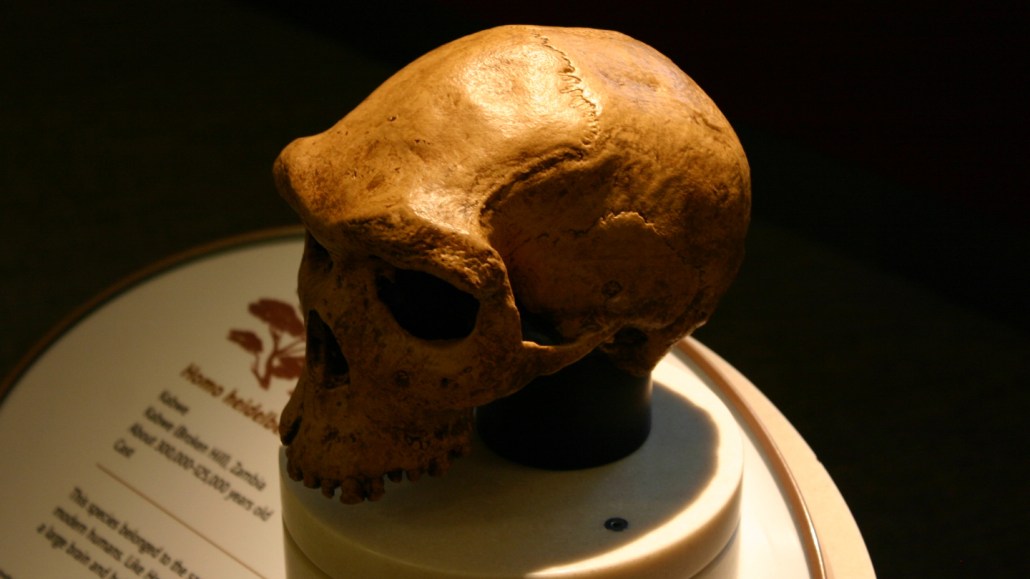Extreme cold may have nearly wiped out human ancestors 900,000 years ago
Ancestral populations rebounded by about 100,000 years later, a contested DNA analysis suggests

Modern human DNA indicates that human ancestors may have brushed up against extinction starting around 900,000 years ago before bouncing back and possibly evolving into Homo heidelbergensis, a species represented by the African fossil skull shown here.
RYAN SOMMA/FLICKR (CC BY-SA 2.0)
Human ancestors nearly died out between around 930,000 to 813,000 years ago in an evolutionarily pivotal population bust, a contested new study concludes.
This potential winnowing of human ancestors into a barely sustainable number of survivors coincided with a period of extreme cold and extended droughts in Africa and Eurasia, previous geologic evidence indicates.
If the new DNA-derived scenario holds up, relatively few survivors of the Stone Age big chill may have evolved into a species ancestral to Homo sapiens, Neandertals and Denisovans, say population geneticist Wangjie Hu of the Icahn School of Medicine at Mount Sinai in New York City and colleagues. Previous analyses of DNA extracted from ancient fossils estimate that this common ancestral species appeared between around 700,000 and 500,000 years ago.
Not too long before that, members of the human genus, Homo, weathered a roughly 117,000-year-long freeze while maintaining an average of 1,280 individuals capable of breeding, the researchers report in the Sept. 1 Science. That number of our evolutionary precursors reproduced just enough to stave off extinction, they say.
Before the onset of the harsh climate, the number of potential breeders in the same ancestral population had totaled between 58,600 and 135,000 individuals, the team estimates.
Hu’s team devised a new statistical method to estimate the timing and sizes of ancient breeding populations using patterns of shared gene variants in human populations today. The modern genetic data came from 3,154 people in 10 African populations and 40 non-African populations. Hu’s group obtained that information from two scientific databases of human DNA.
The scientists calculated the expected diversity of these modern variants based on hypothetical ancient population histories, some of which included periods of drastic declines in numbers of breeding adults. A population crash among human ancestors that lasted from about 930,000 to 813,000 years ago best accounted for the genetic variation in the analyzed data, the researchers conclude.
Africans displayed much stronger genetic evidence of an ancient population crash than non-Africans did, the scientists found. A depleted population of human ancestors probably lived in Africa starting around 900,000 years ago, although Eurasia cannot be excluded as a home region for those survivors, the team says.
As that diminished population began to rebound, its members may have evolved into H. heidelbergensis, Hu’s group suspects (SN: 4/13/22). Some researchers regard H. heidelbergensis as an ancestor of Denisovans, Neandertals and H. sapiens that first appeared around 700,000 years ago in Africa and Eurasia. But other scientists say that fossils assigned to H. heidelbergensis contain too many skeletal differences to qualify as a single Homo species.
In a comment published with the new study, archaeologist Nick Ashton of the British Museum in London and paleoanthropologist Chris Stringer of London’s Natural History Museum provisionally accept the new estimate of an ancient population crash among human ancestors.
Even so, an increasing number of fossil discoveries suggest that groups in the Homo genus occupied various parts of Africa, Asia and Europe between roughly 900,000 and 800,000 years ago, during the newly proposed population crunch, Ashton and Stringer say.
Hu’s team suggests that populations unrelated to later H. sapiens that lived on those continents may somehow have survived severe global cooling better than groups related to people today. DNA from ancient H. sapiens, Neandertals and Denisovans will help to clarify when and where ancient population crashes occurred, Ashton and Stringer say.
Hu and colleagues’ report raises the possibility that ancestral human populations temporarily suffered a steep drop in numbers and formed small groups that rarely mated with each other, says population geneticist Aaron Ragsdale of the University of Wisconsin–Madison.
But confirmation of the new findings must come from genetic studies that account for ancient fluctuations in population density, geographic range and interbreeding as well as population size, Ragsdale says.
Because estimated sizes of ancient breeding populations often downplay actual population numbers, “it’s a stretch to say that ancestral human populations were close to extinction,” he says.
Population geneticist Stephan Schiffels of the Max Planck Institute for Evolutionary Anthropology in Leipzig, Germany sees no reason to accept the new study’s conclusions. Interconnected ancestries among ancient Homo groups and statistical uncertainties in determining their genetic ties obscure any molecular signals of population collapses that occurred nearly 1 million years ago, Schiffels contends.
“The suggested precision in dating events like this [proposed ancient population crash] is not possible,” he says.
Present-day human DNA analyzed in the new study has been studied and modeled for years by other investigators, none of whom have cited any signs of such an ancient, steep population decline, Schiffels says.
But severe climate shifts could potentially have pushed human ancestors and other species close to or over the brink of extinction, says population geneticist and study coauthor Ziqian Hao of Shandong First Medical University in Jinan, China. In the Aug. 11 Science, another team — including Ashton and Stringer — described ancient climate reconstructions indicating that a previously unrecognized cold phase in Europe led to sharp declines in hominid numbers about 1.1 million years ago.
Hu and colleagues plan to incorporate ancient hominid DNA and a larger sample of present-day human DNA, especially from Africa, into further analyses of ancient population ups and downs.







